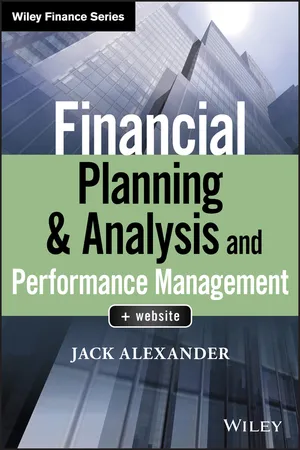
- English
- ePUB (mobile friendly)
- Available on iOS & Android
Financial Planning & Analysis and Performance Management
About This Book
Critical insights for savvy financial analysts
Financial Planning & Analysis and Performance Management is the essential desk reference for CFOs, FP&A professionals, investment banking professionals, and equity research analysts. With thought-provoking discussion and refreshing perspective, this book provides insightful reference for critical areas that directly impact an organization's effectiveness. From budgeting and forecasting, analysis, and performance management, to financial communication, metrics, and benchmarking, these insights delve into the cornerstones of business and value drivers. Dashboards, graphs, and other visual aids illustrate complex concepts and provide reference at a glance, while the author's experience as a CFO, educator, and general manager leads to comprehensive and practical analytical techniques for real world application.
Financial analysts are under constant pressure to perform at higher and higher levels within the realm of this consistently challenging function. Though areas ripe for improvement abound, true resources are scarce—until now. This book provides real-world guidance for analysts ready to:
- Assess performance of FP&A function and develop improvement program
- Improve planning and forecasting with new and provocative thinking
- Step up your game with leading edge analytical tools and practical solutions
- Plan, analyze and improve critical business and value drivers
- Build analytical capability and effective presentation of financial information
- Effectively evaluate capital investments in uncertain times
The most effective analysts are those who are constantly striving for improvement, always seeking new solutions, and forever in pursuit of enlightening resources with real, useful information. Packed with examples, practical solutions, models, and novel approaches, Financial Planning & Analysis and Performance Management is an invaluable addition to the analyst's professional library. Access to a website with many of the tools introduced are included with the purchase of the book. Please see About the Website page for access instructions.
Frequently asked questions
1
FINANCIAL PLANNING & ANALYSIS AND BUSINESS PERFORMANCE MANAGEMENT
CHAPTER INTRODUCTION
Financial Planning & Analysis (FP&A) and Performance Management (PM) are critical functions to the success of any enterprise. In this chapter, we will define what we believe productive FP&A and PM functions should include, and we will preview the contents of the remainder of the book. We will use the terms FP&A and PM interchangeably to encompass these two related and overlapping disciplines.
THE PROBLEM WITH TRADITIONAL MEASUREMENT SYSTEMS
OBJECTIVES OF FINANCIAL ANALYSIS AND PERFORMANCE MANAGEMENT

- Achieving an organization's goals and objectives, including strategic and operational initiatives, forecasts, and planned results.
- Projecting and modeling future financial performance.
- Monitoring performance on key value and business drivers.
- Increasing visibility into critical areas of business performance, allowing managers to assign and enforce accountability for performance.
- Providing an effective framework, allowing managers and employees to understand how their activities relate to operating and financial performance, and ultimately to the value of the company.
- Providing early detection of unfavorable events...
Table of contents
- COVER
- TABLE OF CONTENTS
- PREFACE
- ABOUT THE WEBSITE
- 1 FINANCIAL PLANNING & ANALYSIS AND BUSINESS PERFORMANCE MANAGEMENT
- Part One: Fundamentals and Key FP&A Capabilities
- Part Two: Performance Management
- Part Three: Business Projections and Plans
- Part Four: Planning and Analysis for Critical Business and Value Drivers
- Part Five: Valuation and Capital Investment Decisions
- Part Six: Summary
- ACKNOWLEDGMENTS
- ABOUT THE AUTHOR
- INDEX
- END USER LICENSE AGREEMENT